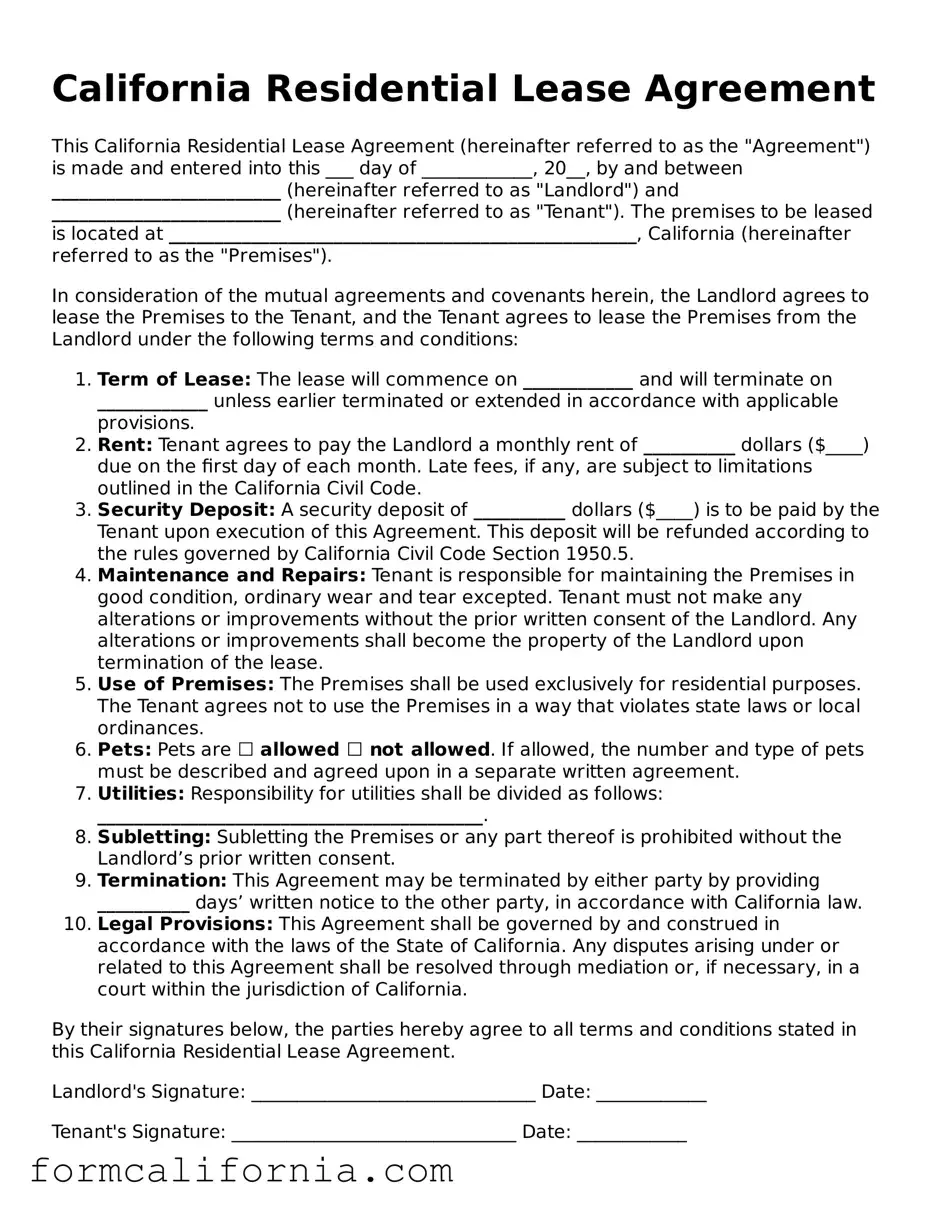The California Residential Lease Agreement shares similarities with a sublease agreement. Both documents govern the terms under which someone may rent real estate, but a sublease agreement uniquely comes into play when a current tenant wishes to rent out their leased premises to another party. It operates under the umbrella of the original lease, inheriting many of its terms, ensuring that subtenants adhere to the initial lease conditions agreed upon by the original tenant and landlord.
Comparable to a Residential Lease Agreement is the rental application form. This document is used by landlords to screen potential tenants before finalizing a lease agreement. It collects personal and financial information from prospective renters, aiding in the decision-making process. Although it doesn't establish a binding agreement for occupancy, it is a crucial step towards creating a lease agreement, serving to protect the interests of the property owner by vetting the background and reliability of applicants.
Another document akin to the California Residential Lease Agreement is the room rental (roommate) agreement. This agreement is used when individuals decide to share a rented living space, detailing the specifics of their arrangement, such as rent distribution, utilities, and shared responsibilities. While it does not replace a lease agreement with a landlord, it complements it by structuring a peaceful cohabitation environment among tenants, underscoring their individual and collective obligations.
A month-to-month rental agreement also shares characteristics with the typical lease agreement but with a significant distinction regarding duration and termination. Unlike a fixed-term lease, which has a set end date, a month-to-month agreement offers flexibility, allowing either party to terminate the contract with proper notice, usually 30 days. This type of agreement benefits both landlords and tenants who seek or provide temporary housing without the commitment to a long-term lease.
The Lease Renewal Agreement is closely related to the original lease agreement and is used to extend the term of an existing lease between a tenant and landlord. It provides an opportunity to adjust the rental terms, such as rent amount, to reflect current market conditions or changes in the parties’ circumstances. Essentially, it reinstates most terms of the original lease, providing continuity while allowing for necessary updates.
Similar in function to the Residential Lease Agreement is the Property Management Agreement. This contract is between a property owner and a management company or individual property manager, authorizing them to operate, control, and oversee the property, including managing leases with tenants. It outlines the manager’s responsibilities, fees, and the extent of their authority, essentially serving as the operational blueprint for the leasing and maintenance of the rental property.
Comparable to a lease agreement is the Commercial Lease Agreement, albeit for business properties. This contract outlines the terms under which a tenant can rent commercial premises from a landlord. While structurally similar to a residential lease, it includes considerations unique to commercial use, such as clauses about zoning laws, renovations, and termination rights relevant to business operations, reflecting the different regulations and expectations involved in commercial tenancies.
An Eviction Notice, though not a contract like a lease agreement, is closely related in the context of tenancy. It is a formal document a landlord issues to a tenant to commence the process of legally removing them from the rental property. Reasons for eviction include breach of lease terms, such as non-payment of rent or damage to the property. It is an unfortunate, yet sometimes necessary, following up to a lease agreement when terms are violated.
The Tenant's Notice to Vacate is a document initiated by the tenant, signaling their intention to leave the rental property. This notice respects the terms of the lease agreement regarding vacating the premises, typically requiring 30 days' notice. It embodies the tenant's compliance with the lease’s termination procedures, allowing the landlord to prepare for re-leasing the property and ensuring a smooth transition for both parties.
Lastly, a Late Rent Notice bears resemblance to the lease agreement as it is a direct consequence of a tenant's failure to adhere to one of the central terms of the lease: timely rent payments. This notice documents the issue of late payment and often precedes more drastic measures, like eviction. It outlines the amount owed, any late fees, and the deadline for payment, reinforcing the importance of fulfilling financial commitments outlined in the lease agreement.
